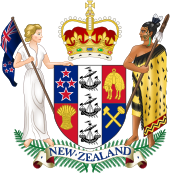Wildlife Act 1953
| Wildlife Act 1953 | |
|---|---|
 |
|
| New Zealand Parliament | |
| An Act to consolidate and amend the law relating to the protection and control of wild animals and birds, the regulation of game shooting seasons, and the constitution and powers of acclimatisation societies | |
| Status: Current legislation |
Wildlife Act 1953 is an Act of Parliament in New Zealand.
Under the act, the majority of native New Zealand vertebrate species are protected by law, and may not be hunted, killed, eaten or possessed. Violations may be punished with fines of up to $100,000.
Wildlife are classified under a number of schedules; all vertebrate species not included in these lists are protected by default. The schedules are periodically amended; for example the kea was granted full protection in 1984, whereas the spur-winged plover (masked lapwing), an Australian species which naturally established itself in New Zealand in the 1930s, had its protected status removed in 2012.
This group comprises commonly hunted waterfowl (mallard, grey duck, Australasian shoveler, paradise shelduck, black swan and pukeko) and introduced game birds, including pheasant, quail, chukar and partridge. These birds may be hunted during the open season, which begins in early May and lasts approximately four weeks.
This group comprises just the little owl, the silvereye and, on the Chatham Islands only, the brown skua (Catharacta antarctica lonnbergi). It formerly included the kea, which has been blamed for attacking sheep, but is now considered endangered. These birds may be shot by land owners if they pose a threat to crops or livestock, without any need for a permit from the Department of Conversation.
These may be culled on application to the Department of Conservation, subject to whatever restrictions are imposed. This group includes the Australasian harrier, grey teal, grey-faced petrel, mute swan, black shag, little shag, pied shag and sooty shearwater.
...
Wikipedia
